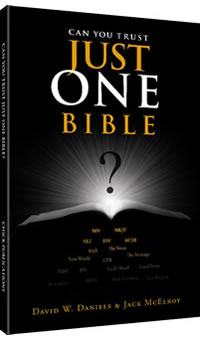Has the King James Bible been changed, between 1611 and the present day?

From "Answers To Your Bible Version Questions"
© 2001 by David W. Daniels
Question: Has the King James Bible been changed, between 1611 and the present day?
Answer: There have only been two modifications of the King James Bible: correction of printing errors and changes in the English Language itself.
Typesetting in the 1600s was a very laborious task. Each letter on each page had to be put into place. Since there are 3,566,480 letters in the Bible, that leaves a lot of room for mistakes. But in 1628, only 27 years after the first editions of the Bible were printed, 72% of the around 400 printing corrections were already accomplished. By 1850 all corrections of printing errors were made (with the exception of two which shall be detailed below).
The King James Bible was originally printed in Gothic type. That means "v" looked like "u," "J" looked like "I," and there was an "s" that appeared in certain words that looked a little like our "f." So "Iefvs" in Gothic type was the same as "Jesus" in Roman type. The Bibles we read now are in Roman type. Changing the type from Gothic to Roman has been labeled by some as a "change," but it really is not. The words themselves were not changed, only the way the letters were written.
But the spelling of words also changed. By the 1800s, "wee" was "we, "fheepe" was "sheep," "sayth" was "saith," and "euill" was "evil." But those spellings are not difficult. You can figure out what the words said, even from a 1611 copy.
This is a very important point —there was not a single textual change in the King James Bible. But the New King James (NJKV) is a different story. The NKJV is not a true King James Bible. The NKJV publishers used different manuscripts and introduced completely different meanings into their texts. They did not stay with the accurate, preserved meanings of Hebrew and Greek words you find in your King James Bible. They switched words to be what you find in a NIV, NAS or RSV. I will say it again: the King James Bible has no textual changes in any edition, whatsoever.
There are actually two single mistakes that were introduced by printers at Oxford University Press over 60 years after the KJV was first printed. They are in 2 Chronicles 33:19, where it says "sins" instead of "sin," and Jeremiah 34:16, where they mistakenly printed "whom he" instead of the correct "whom ye." Both of these were originally translated correctly. But Oxford printers made these two mistakes. Cambridge University Press did not make the printing error. And all Cambridge-type texts have the correct readings. But some publishers misprint one or the other verse in their Bibles. Amazingly, the New King James also has the same Oxford mistake in Jeremiah 34:16!
Put to the Test
In the 1850s, after the typographical corrections and spelling changes were completed in the King James, the American Bible Society wrote *two reports on the present condition of the English Bible. In the second report was this statement:
"[The] English Bible as left by the translators has come down to us unaltered in respect to its text."
The simple fact is that the King James Bible you can purchase in almost any bookstore, allowing for changes in spelling (and possibly the two printing errors), is the same Book of God's preserved words that was printed in 1611. We can thank God for that.
Footnote
*In 1852 the American Bible Society wrote Committee on Versions to the Board of Managers. In 1858 a second report was written, Report of the Committee on Versions to the Board of Managers of the American Bible Society. This information can be found Dr. Thomas Holland's book, Crowned with Glory: The Bible from Ancient Text to the Authorized Version, p. 101.
- See more articles on related topics:
- Bible Versions
- King James Bible
- History of Preservation
Products of interest:
-

51 Reasons Why The King James
224 pages
Here are 51 reasons to trust that God kept His promise to preserve His own words. -

Answers to Your Bible Version Questions
224 pages
David W. Daniels answers difficult questions about the KJV. Learn how to defend the KJV and why you can trust it. -

Can You Trust Just One Bible?
160 pages
Answers to the most common anti-KJV accusations.
